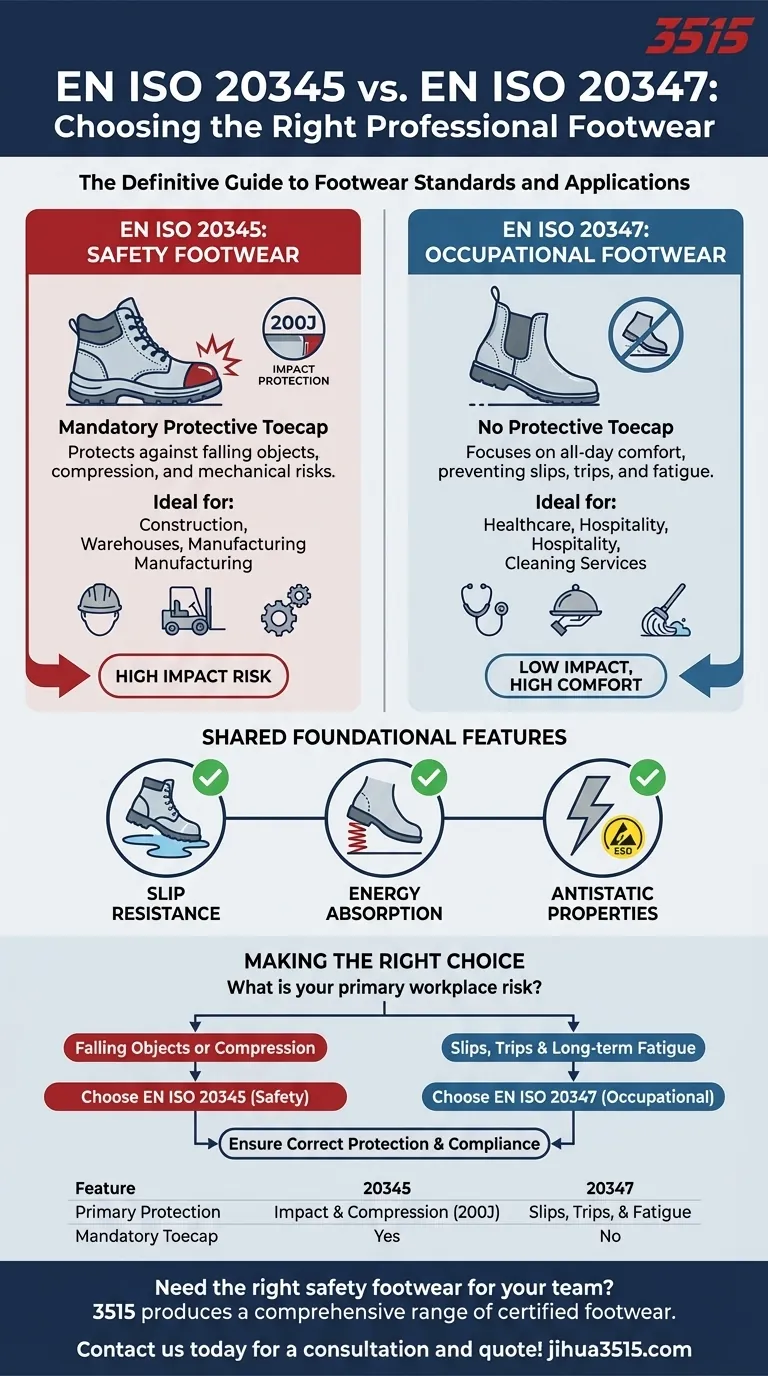The fundamental difference between EN ISO 20347 and EN ISO 20345 lies in the presence or absence of a protective toecap. EN ISO 20345 defines safety footwear and mandates a toecap that resists a 200-Joule impact, designed for environments with a risk of falling objects. In contrast, EN ISO 20347 defines occupational footwear, which does not have a protective toecap and is intended for lower-risk environments where impact hazards are not present.
Your choice is not about which standard is "better," but which is appropriate for the specific risks in your environment. EN ISO 20345 protects against mechanical impact, while EN ISO 20347 focuses on preventing slips, trips, and fatigue.

The Defining Feature: Toecap Protection
The primary distinction between these two standards is straightforward and absolute. It determines the classification of the footwear and its intended use.
EN ISO 20345: Safety Footwear
This standard is for footwear designed to protect the wearer's feet from foreseeable impact and compression injuries.
The core requirement is a protective toecap capable of withstanding a 200-Joule impact. This is the level of protection needed to guard against a heavy object (approximately 20kg) dropping from a height of about one meter.
This makes it the mandatory standard for environments with significant mechanical risks, such as construction sites, warehouses, manufacturing facilities, and logistics centers.
EN ISO 20347: Occupational Footwear
This standard applies to footwear that offers protection from risks other than mechanical impact or compression.
By definition, footwear certified to EN ISO 20347 does not have a protective toecap. Its purpose is to provide comfort, support, and safety in environments where the primary hazards are different.
It is best suited for professions like healthcare, hospitality, cleaning services, and other roles where long hours are spent on foot and the main risks are slips or fatigue.
Comparing Core Requirements
While the toecap is the main differentiator, both standards share foundational safety requirements and specify additional protective features.
Slip Resistance
A basic level of slip resistance is a fundamental requirement for footwear under both standards. This is a critical safety feature in almost every work environment.
Energy Absorption
Both standards require a degree of energy absorption in the heel area. This feature is crucial for reducing fatigue and minimizing stress on the body during long periods of standing or walking.
Antistatic Properties
Many work environments require footwear with antistatic properties to prevent the build-up of static electricity. This feature can be found in footwear certified to either standard, depending on the specific model.
Understanding the Trade-offs and Applications
Choosing the wrong standard for your environment can lead to unnecessary discomfort or, more seriously, a critical failure in protection.
When to Mandate Safety Footwear (EN ISO 20345)
You must select EN ISO 20345 certified footwear when a risk assessment identifies any potential for foot injury from falling objects, rolling equipment, or compression.
The primary trade-off is often slightly increased weight and potentially less flexibility due to the reinforced toecap. However, this is a non-negotiable compromise for ensuring safety against mechanical hazards.
When to Choose Occupational Footwear (EN ISO 20347)
Occupational footwear is the correct choice when the risk assessment shows no danger of impact or compression.
The focus here shifts to all-day comfort, stability, and protection from slips and liquid spills. Using this lighter, more flexible footwear significantly reduces fatigue in roles that demand constant movement. The critical trade-off is the complete absence of impact protection.
Making the Right Choice for Your Environment
Your decision must be driven by a clear understanding of the workplace hazards.
- If your primary risk is falling objects or compression: You must choose footwear certified to EN ISO 20345 to ensure adequate impact protection.
- If your primary risk is slips, trips, and long-term fatigue: Footwear certified to EN ISO 20347 is the appropriate and more comfortable choice.
- If you work in a static-sensitive environment: Ensure your chosen footwear, regardless of standard, has the specific rating for antistatic (A) or ESD properties.
Matching the footwear standard to the identified risk is the foundation of an effective and compliant safety program.
Summary Table:
| Feature | EN ISO 20345 (Safety Footwear) | EN ISO 20347 (Occupational Footwear) |
|---|---|---|
| Primary Protection | Impact & Compression (200-Joule toecap) | Slips, Trips, & Fatigue |
| Mandatory Toecap | Yes | No |
| Ideal For | Construction, Warehouses, Manufacturing | Healthcare, Hospitality, Cleaning |
| Key Focus | Impact Safety | All-Day Comfort & Stability |
Need the right safety footwear for your team? As a large-scale manufacturer, 3515 produces a comprehensive range of EN ISO 20345 and EN ISO 20347 certified footwear for distributors, brand owners, and bulk clients. Our production capabilities encompass all types of safety and occupational shoes and boots, ensuring you get the perfect fit for your specific workplace hazards and compliance needs. Contact us today for a consultation and quote!
Visual Guide

Related Products
- Safety Footwear Wholesale Manufacturer for Custom OEM/ODM Production
- Advanced KPU Athletic Safety Shoe with Steel Toe Cap Anti-Slip Rotary Lacing System
- Premium Suede Sport Safety Shoes for Wholesale & Bulk Orders
- Wholesale Durable Safety Boots | Custom Steel Toe & Puncture-Resistant Manufacturing
- Wholesale Safety Footwear Manufacturer for Bulk & Custom OEM Orders
People Also Ask
- What are the cultural perspectives on wearing shoes in the house? A Guide to Home Etiquette & Hygiene
- Do snake bite boots work? Your Ultimate Guide to Effective Snake Bite Protection
- How do safety shoes contribute to cost savings for companies? A Strategic Investment in Risk and Cost Management
- What are OSHA approved shoes? Understanding the Correct Standards for Workplace Safety
- How long can you wear safety boots? The Lifespan is Determined by Wear, Not Time



















